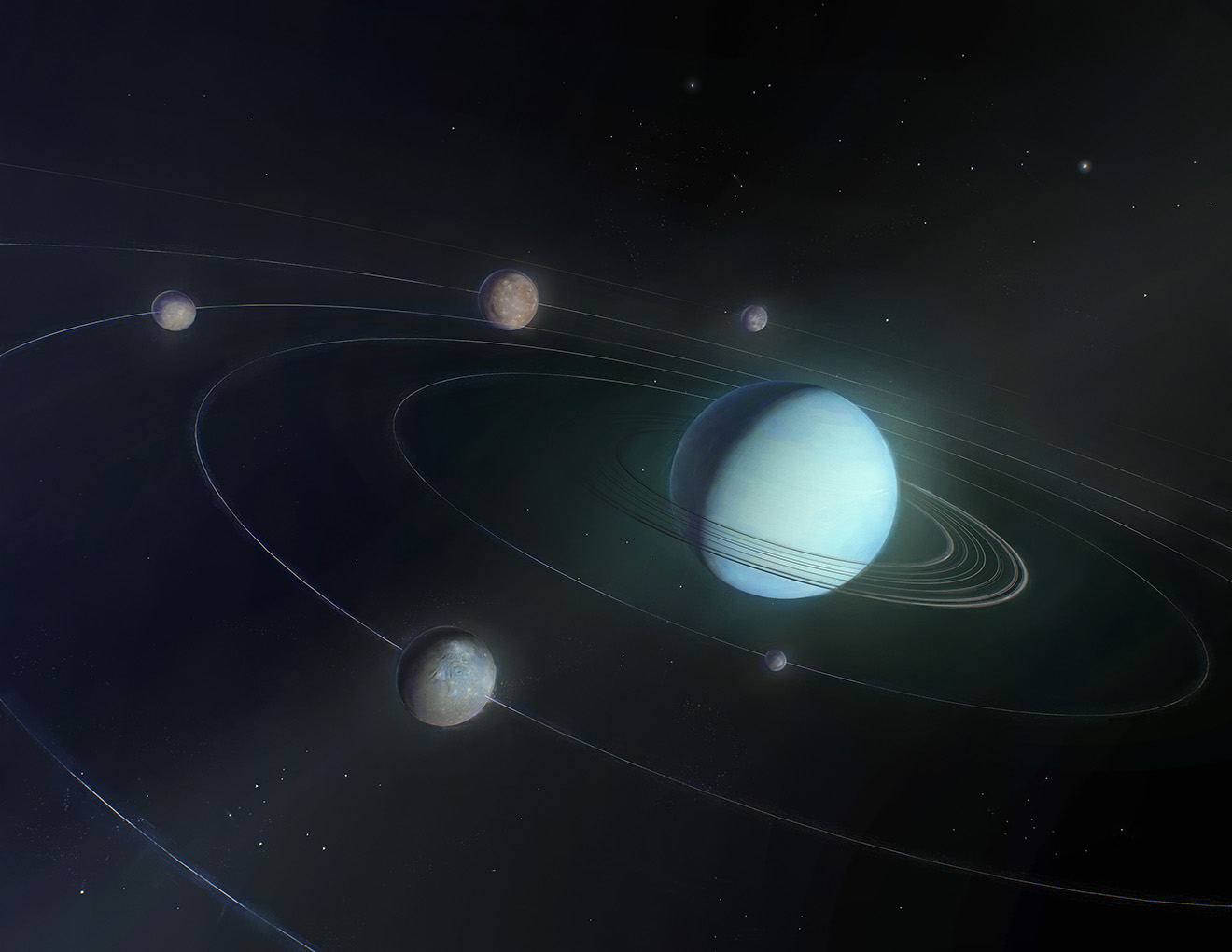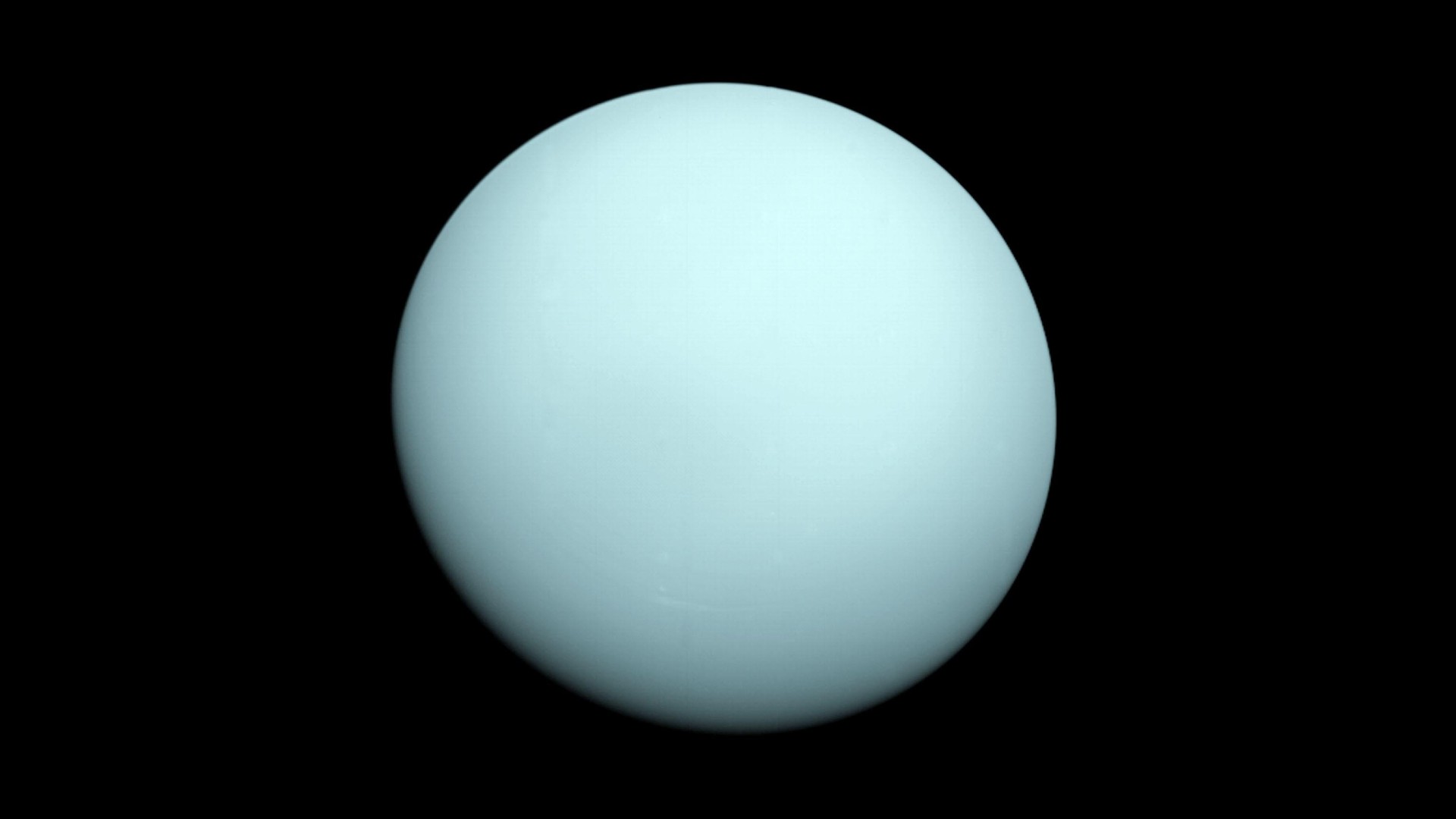
Two of Uranus' moons may have active oceans that are pumping material into space, a new study finds.
The realization that there may be more happening in the Uranus system than previously believed came via the discovery of strange features in radiation data collected by NASA's Voyager 2 spacecraft as it passed the planet almost four decades ago.
The new findings, concerning the moons Ariel and Miranda, also support the idea that Uranus' five largest satellites could have subsurface oceans, a notion suggested by Voyager 2 flyby observations.
Related: Photos of Uranus, the tilted giant planet

The study team examined radiation and magnetic data collected by the spacecraft in 1986, long before it made its way out of the solar system.
The newly reported observations of Voyager 2 — currently the only spacecraft to have visited Uranus — showed that one or two of the ice giant's 27 known moons are adding plasma particles into the Uranus system. This detection came in the form of "trapped" energetic particles the spacecraft spotted as it departed the ice giant.
The mechanism by which Miranda and/or Ariel may be doing this is currently unknown, but there is one very tantalizing possible cause: One or both of the icy moons may possess a liquid ocean beneath their frozen surface that's actively blasting plumes of material into space.
Similar particle-releasing moons exist around Uranus' fellow solar system ice giant Neptune and the gas giants Jupiter and Saturn. In the case of the Jupiter moon Europa and Saturn's Enceladus, it was the examination of particle and magnetic field data that provided the first hints that these are ocean moons.
"It isn't uncommon that energetic particle measurements are a forerunner to discovering an ocean world," study lead author Ian Cohen, a space scientist at the Johns Hopkins Applied Physics Laboratory (APL) in Laurel, Maryland, said in a statement.
"We've been making this case for a few years now, that energetic particle and electromagnetic field measurements are important not just for understanding the space environment but also for contributing to the grander planetary science investigation," Cohen added. "Turns out that can even be the case for data that are older than I am. It just goes to show how valuable it can be to go to a system and explore it first-hand."
Related: Why scientists want NASA to send a flagship mission to Uranus
Another look at Uranus and its moons
The findings will only strengthen the desire of planetary scientists to send spacecraft back to Uranus and Neptune to collect more data, which led to the suggestion of a $4.2 billion flagship mission to Uranus as NASA's next major planetary mission.
This mission wouldn't be ready to launch until the early 2030s, so in the meantime, researchers have been diving back into old data collected during the Voyager 2 flyby to make new discoveries.
The data examined by Cohen and the team was collected by the APL-built Low-Energy Charged Particle (LECP) instrument on Voyager 2, which characterized the population of trapped particles.
"What was interesting was that these particles were so extremely confined near Uranus' magnetic equator," Cohen said. He explained that this is strange because magnetic waves within the system would normally cause the particles to spread out, but these were cramped together near the planet's equator, between Ariel and Miranda.
The team had to eliminate the possibility that the crowded particles detected by Voyager 2 could be the result of the spacecraft flying through a chance plasma stream from the tail of Uranus' magnetosphere. They determined that, were this the case, the feature would have a broader spread of particles than were spotted by Voyager 2, thus allowing them to rule this out as an explanation for the unusual data feature.
Cohen and the team then began to explore simple physical models, using knowledge about ocean moons developed and acquired since Voyager 2 made its Uranus flyby 37 years ago to recreate the data collected by the spacecraft. This indicated to them that the feature could have come only from a strong and consistent source of particles, with a specific mechanism to energize them.
They ruled out other possible explanations, arriving at the theory that the trapped particles come from at least one of Uranus' moons, with Ariel and/or Miranda being the leading suspects. The team thinks that the particles were ejected in the form of a vapor plume similar to those seen erupting from Enceladus. Another possible ejection mechanism is "sputtering," a process in which high-energy particles collide with a surface, triggering the ejection of other particles into space.
"Right now, it's about 50-50 whether it's just one or the other," Cohen said, referring to the plume and sputtering hypotheses.
Whichever ejection mechanism is at work in the Uranus system, the mechanism that gives these particles their energy is pretty much the same.
This energizing mechanism is likely to be a constant stream of particles flowing from the moons into space, generating electromagnetic waves. These waves then accelerate a small fraction of these particles to energy great enough to be detected by the LCEP instrument. This process would also keep the particles trapped and thus tightly confined, just as Voyager 2 saw.
More data would need to be collected from the region around Uranus before scientists could conclusively determine that the particles come from subsurface oceans on Ariel and/or Miranda.
"The data are consistent with the very exciting potential of there being an active ocean moon there," Cohen concluded. "We can always do more comprehensive modeling, but until we have new data, the conclusion will always be limited."
The team's results were presented at the 54th annual Lunar and Planetary Science Conference on March 16 and have been accepted for publication in the journal Geophysical Research Letters.
Follow us on Twitter @Spacedotcom and on Facebook.







